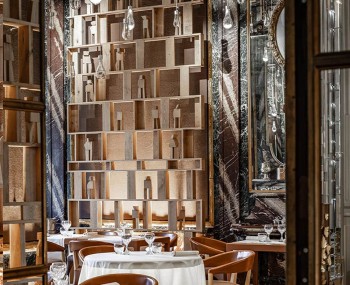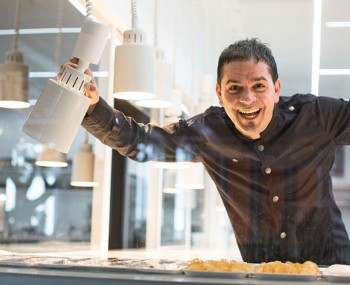The tasting menu at Glass Hostaria is a travel almanac with a delicate script, yet intimately familiar; not a Da Vinci Code, but a CliffsNotes of global cuisines. Here’s how Cristina Bowerman has made modernity a form of sharing.
Photo (unless otherwise indicated): credits Struttura Films
2006: The usual sleepy Rome and a small case history in Trastevere. Just under 20 years ago, between the neighborhood shopkeeper and the crowded square of the nightlife scene, a sign emerged that was destined to change the rhythm of the local hustle and bustle, broadening the horizons of tourist Rome—or rather, the perception of the locals themselves. Glass Hostaria became the epicenter of a transformation, a whirlwind within the routine; almost a breach of the future in the immobility of time. Yet, its gentle shake-up brought momentum to the most unexpected place for gourmet growth.
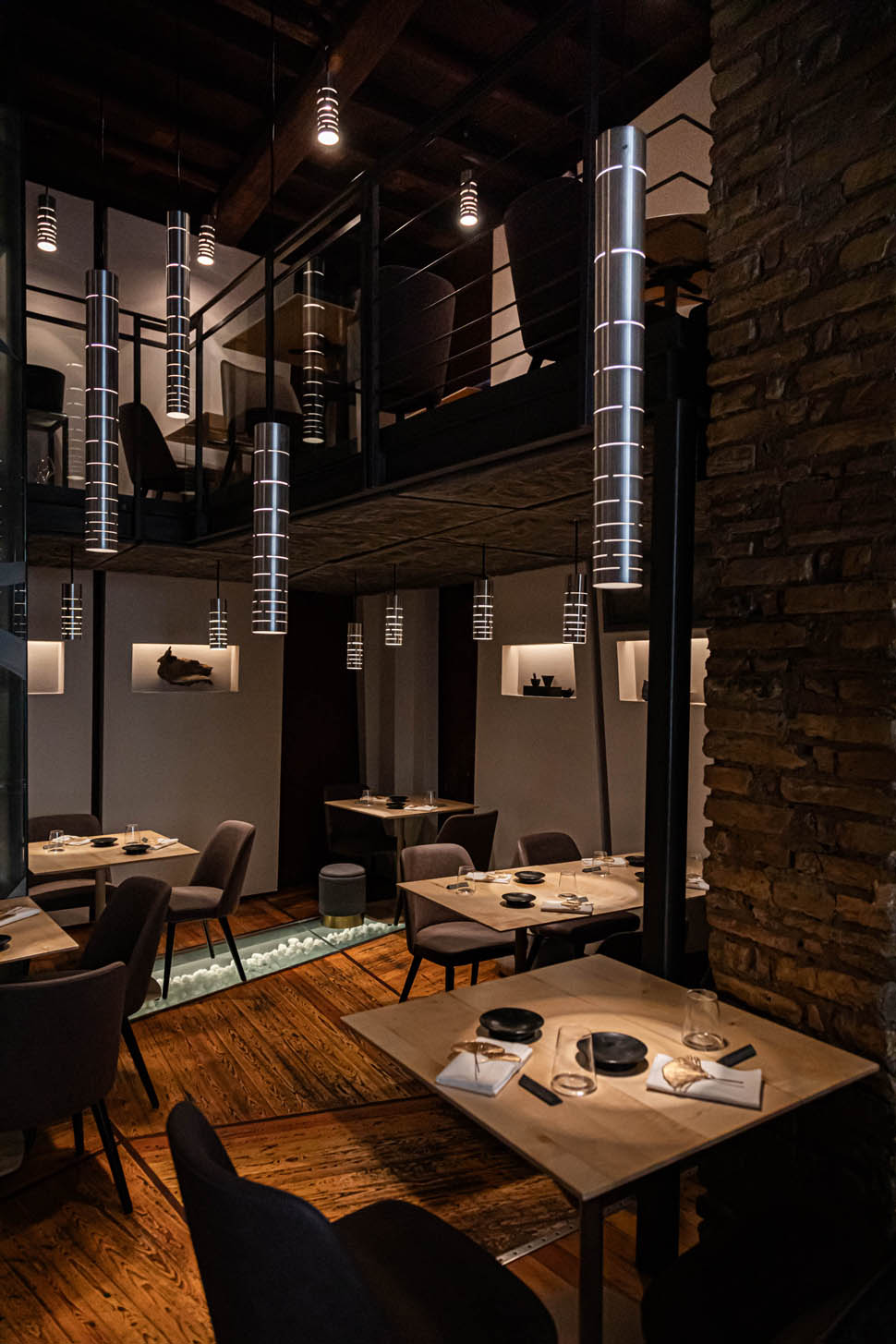
Cristina Bowerman entered with the multifaceted experience of someone who hasn't just been cooking all their life—far from it. With studies in Law, an intensive stint as a graphic designer, and then yes, plenty of restaurant work, but across the States, starting from a coffee house and earning another precious diploma, this time in Culinary Arts.
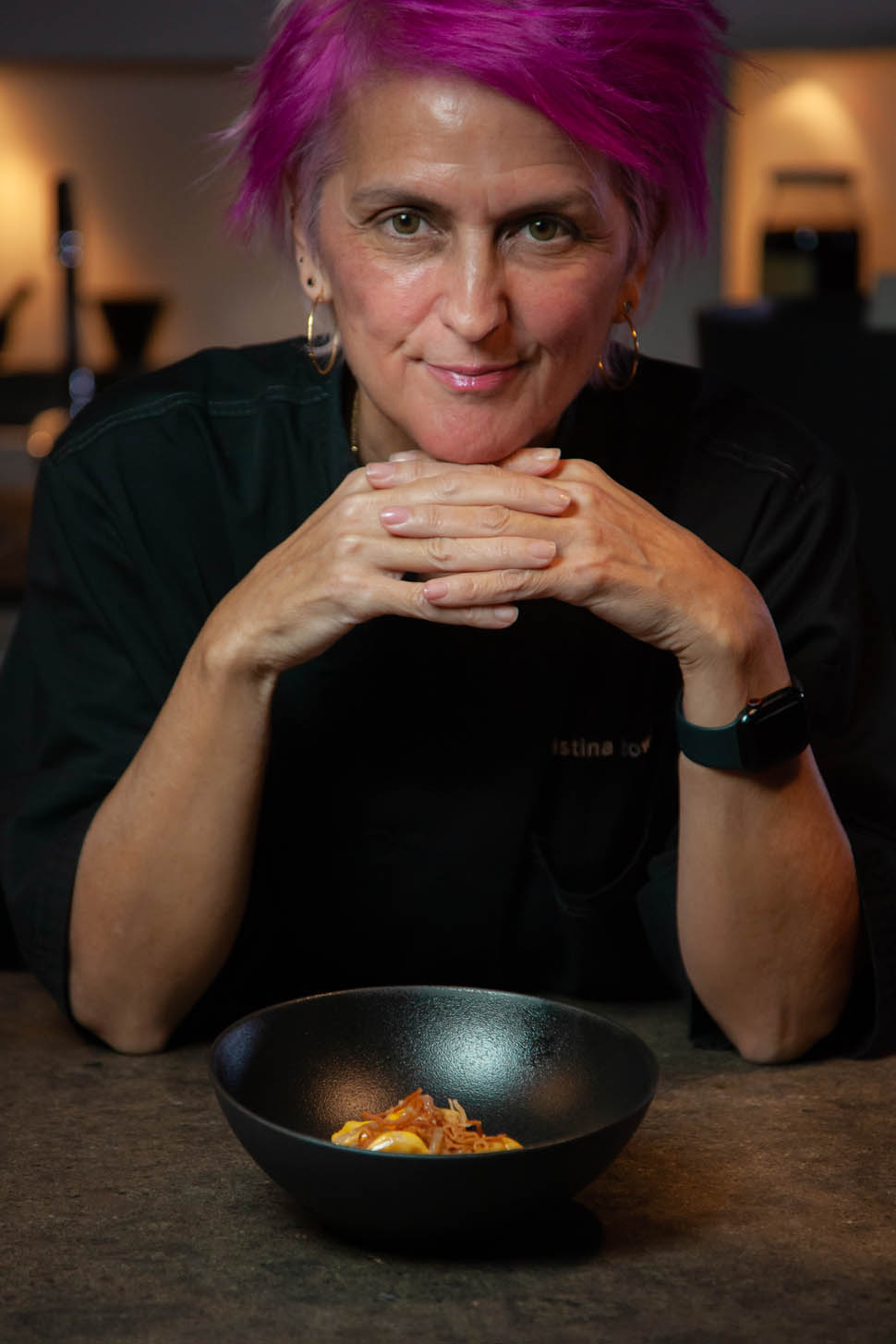
Born in Puglia and passport in hand, Cristina migrated from Austin to San Francisco, finally planting her flag in the Eternal City. It was then that, after a brief but intense period with the Troiani brothers, she redrew the gastro-physical map of Trastevere—right there, among those alleys imbued with unyielding authenticity (or voracity, depending on how you see it).
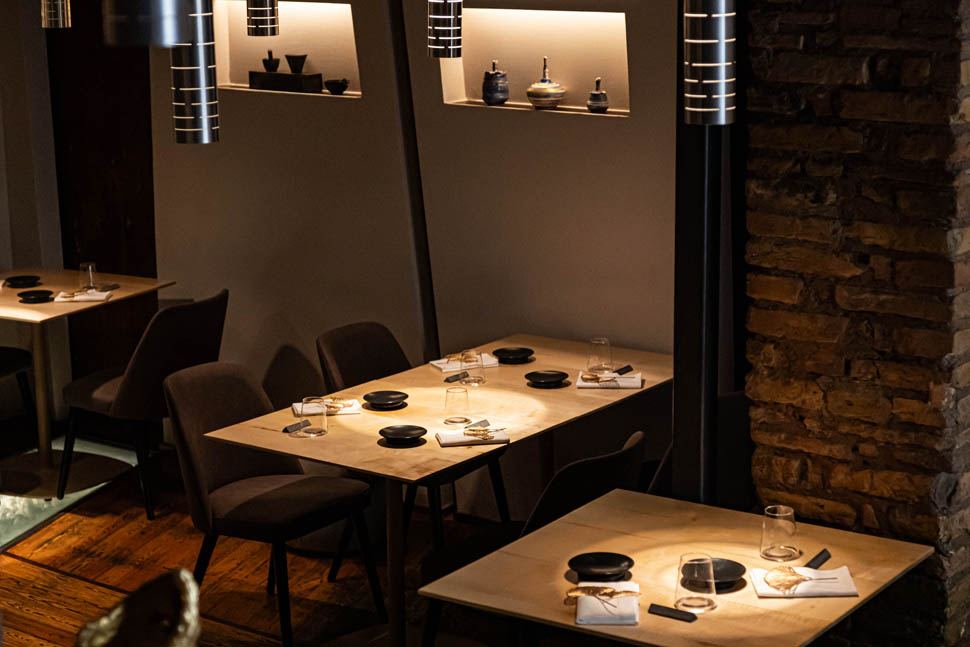

Soon, reservations started pouring in from a decidedly patchwork audience: beyond the familiar palates, there was the Roman who was allergic to tasting menus but converted in the space of an evening; the discerning foodie traveler; the family treating themselves to a gourmet dinner. What is Glass today? It is not a polished dining table, nor an ambition resting on a pedestal of forks and macarons. It is a login into the protected area of haute cuisine with an all-inclusive key. The confirmation—among so many creative acrobatics folded in on themselves—that modernizing doesn't mean distancing: modernity belongs to those who know how to share.

The restaurant
"I know my people well: there is life beyond the team. Sometimes we forget that a restaurant is made of people. Instead, we should remember that the alchemy of a meal lies entirely in human synergy." Cristina begins the conversation like this, decisively pressing the collective button; a behind-the-scenes switch that illuminates faces instead of roles. But the message, in the end, reaches you right in the dining room, where the energy translates not into tension, but into a spontaneous surge of connection with others.

This can happen by lifting the veil of shyness from the solitary customer sitting in their secluded corner; recalling, after years, the spark of love for that out-of-order label that returns to the table like an old friend met unexpectedly; finally, by capturing the rhythms of tastings and pauses, because haste stays outside the door here: the only thing that matters is the free rhythm of each bite.

"I believe in the deep link between those who eat and those who cook. We have always tried to avoid the unknown food syndrome—that sort of surreal disorientation that grips you in front of an uncategorizable dish, making it intimidating from the start. You know the phrase that bounces around your mind if you've enjoyed a place? 'I had an experience.' Well, in my opinion, it perfectly expresses the feeling of being amazed without being frightened. In short, it’s the spark of an instant connection with the chef; it's a landing pad that cushions the leap into the new, so it’s not a leap into the void."

For instance, in 2006, eating fine dining "with your hands" bordered on heresy. Instead, Cristina swam against the current of trends by creating a faux hamburger that activated the latent tactile sphere: "It was actually a licorice bun, foie gras escalope, and passito mayonnaise, with fake rice chips and mango ketchup. It seemed strange in such a place, and it was proposed precisely for this reason." Gesture with the same value as flavor, defying clichés. Moreover, the Olympic myth of the assembled course, a Nordic school. "Why make it a religion? The beauty of our culinary heritage is simultaneity: the act of creating and serving exquisitely expressed dishes. Therefore, except for two meat courses cooked in stages (pork or, occasionally, lamb), I skip the sous-vide and work à la minute. Of course, absolute synchronization is required. The result is that you are not assembling the plate, you are preparing it."

On the other hand, the taste for exploration remains central, embracing countries—and blank maps—in an intercontinental hug. Today, as in the past, Cristina signs a double pact of consistency on the menu: roots present and ready for takeoff. Thus, her blind journey is a travel almanac with a delicate script, yet intimately familiar; not a Da Vinci Code, but a CliffsNotes of international cuisines.

The dishes
The cultural jam session starts right from the beginning, where the match is often played between an arsenal of precise hits and a lineup of inert tastings. The first is successful; at Glass, the amuse-bouches hit the mark thanks to an unusual strategy: none have the foreign-centric approach of flashy snacks for their own sake, as the chef always leaves a hint of Italian-spirit in the appearance or context.

So, instead of macarons and pocket-sized tartlets that typically adorn the welcome gift, a small maritozzo stuffed with salted custard cream, olive powder, and caper leaf arrives, in full Mediterranean style. Then, in the background of the happy hour, a Lotus flower crisp blooms, a typically sweet Thai street food that the chef makes her own with a topping of sesame seeds and Parmigiano Reggiano cream, immediately guiding the senses to umami. In a few minutes, you move from the unexpected liquid-state of the hazelnut butter sphere, ready to flood the palate with a different alcoholic touch each time (in our case, Mai Tai), to the substantial density of a Ligurian panissa that engages the bite with its crunchy peanut enhancement. The cheeks are cleansed by a cube of pineapple made sharp by the cleansing push of vinegar, and then you are really in the moment, ready to start.

To break the ice, a fish ice cream—pardon, sorbet—completely free of eggs and stabilizers, that delicately encapsulates the nobility of the scallop in a fishy morsel: "It contains its coral." Suddenly, you find yourself in open sea, as the rest of the mollusk sails in cold waters with shrimp and king crab tartare. At the base, a robust broth of apples and cider shines, "which I enrich with lemon, lime, and fennel infusion to temper the fruit with the right amount of tartness." Three habitats united in a spoon: coast, soil, waves.

It's a matter of touch, as we wrote in the introduction: "I believe it's natural, from time to time, to ignore utensils, like when you taste a rigatoni during cooking and recover a forgotten sensory aspect," Cristina explains. The warm white corn tortilla, veal heart pastrami, lettuce, and crème fraîche demonstrate this. Simple: fold the ends and bring it to your lips like finger food. But what stands out is the Mexico-Italy pairing. "In the disk, there's no lard; I lightened the recipe while maintaining the crumbly texture of the thinly spread taco. Inside, a veal heart pastrami for the Lazio twist, cured in brine for a week and finished on the grill, preserving the tenderness of the meat softened by osmosis." It is completed with a 'nduja sauce competing with fermented cabbage kimchi; spiciness versus acidity, foreign street food discovering its local roots.

Leavened interlude: the only real risk is being distracted by the small loaf of semi-whole grain and burnt wheat, meant to be dunked into a foam of extra virgin olive oil and black salt. Nevertheless, the first courses advance quickly on the evening's schedule.

The Spaghetto alla Chitarra with seaweed powder in the dough and sea urchin tongue as garnish appears entirely marine. It bursts onto the table flaunting bright cold colors, aided by the tactical addition of parsley to brighten the emerald green. At the base, "a very French Beurre Blanc, where you might not expect it." The element of surprise, however, kicks in only after three forkfuls, each distinct from the previous one. Another principle of the menu, and in general, of the Glass philosophy: "Dynamism satisfies the hunger for curiosity." Thus, against the new wave of intense creaminess, Cristina arranges the pasta "vertically," layering distinct ingredients to be combined as desired. You are the one to mix them, and with each combination, you discover something new. "I wanted a shimmering result that visually conveyed freshness and offered an interactive variation in taste." The credit also goes to an invisible ingredient: the bone marrow incorporated into the seaweed pesto to refine the enveloping texture while supporting the sea urchin's depth. It's a deep dive into the intensity of contrasts, "so much so that you can comfortably drink a red wine with it." For us, it was Cervaro della Sala Antinori 2022: a rich sip between salty and nutty, on the excellent recommendation of the maître d', Riccardo Nocera.

Another first course, another mix. The inspiration for the open ravioli (manti) traditionally filled with braised lamb comes from Turkey. "I Italianize them by replacing the lamb with kid sheep meat, lightly spiced with a blend of turmeric and curry." The same goes for the wrapper: the water and flour of the Near East becomes egg pasta in the Eternal City. More: "To make the surface crispy and slightly browned, I use the gyoza technique, pan-frying on one side only." And suddenly, it borders on Asia. The golden rule? Perfect through subtraction. "Steam cooking, strictly vegetable broth to avoid aromatic overcrowding, and beneath the stuffed boats, a yogurt and tahini cream with a touch of miso." This was our highlight of the dinner, powerful yet light, familiar yet unknown: an "edible syncretism" that nourishes (and opens) the mind.

The lineup of new entries culminates with stuffed quail, dried figs in Marsala, Bronte pistachios, and a swirl of blue potatoes. The bird is deconstructed and reconstructed into a sumptuous total look, from the meat stuffed with offal and dried fruit (both chopped, like pesto, and whole, for texture suspension) to the BBQ leg, all the way to the carcasses reduced into a demi-glace with umeboshi—the Japanese fermented plum vinegar that combines salty and sour notes. On the side, a roll of thin potatoes, almost like the veils of a turban; in the mouth, the caramelized tuber has a sweet note, while a chard leaf resets the palate at the end.

Sometimes they return; this time there are two. The chef plates them both for you at the end of the course, and there is no cutting of the ribbon to separate salts and sugars; rather, a double knot of memories. The revival begins with Corn, passion fruit, and dulce de leche. Cristina shapes a miniature corn cob that recalls the cereal only in form, while the substance changes according to season and imagination, deceiving instinctive perception. It actually contains passion fruit, for a pleasantly tropical touch, accompanied by the "real corn," in the form of popcorn ice cream and its golden kernels. Memories of Texas and, at the same time, home: "My mother used to make them for me."

Then, there are the Ravioli with liquid Parmigiano Reggiano, 100% versatile. They even work in place of dessert, with the cheesy Big Bang that literally bursts through the ethereal dough in which it was trapped. Magic tricks, indeed: a small case history in Trastevere.

Contacts
Glass Hostaria
Vicolo del Cinque, 58, 00153 Rome RM
Phone: 06 5833 5903



